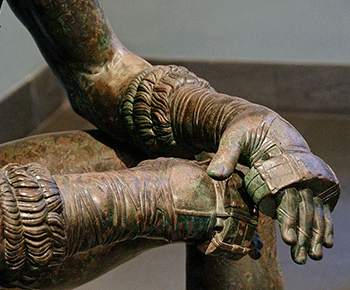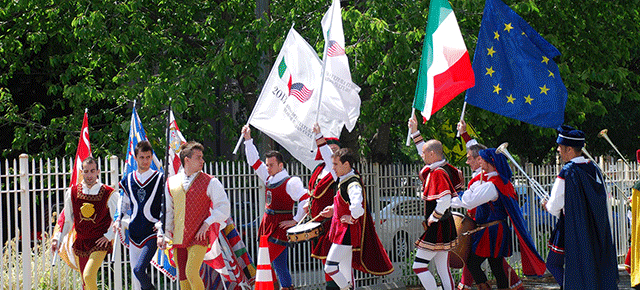The celebrated over-life-size bronze statue Boxer at Rest—an exceptionally realistic ancient Greek sculpture created between the late fourth and the second century B.C., on loan from the Museo Nazionale Romano – Palazzo Massimo alle Terme—will be shown outside Europe for the first time in The Boxer: An Ancient Masterpiece, a special presentation at The Metropolitan Museum of Art, beginning Saturday, June 1 until July 15, 2013. This extraordinary work will be on view for six weeks only.
 The exhibition is organized by The Metropolitan Museum of Art in collaboration with the Italian Ministry of Foreign Affairs, the Ministero per i Beni e le Attività Culturali, and the Museo Nazionale Romano – Palazzo Massimo alle Terme. Support is provided by Eni, the main sponsor of the exhibition.
The exhibition is organized by The Metropolitan Museum of Art in collaboration with the Italian Ministry of Foreign Affairs, the Ministero per i Beni e le Attività Culturali, and the Museo Nazionale Romano – Palazzo Massimo alle Terme. Support is provided by Eni, the main sponsor of the exhibition.
The event is part of 2013 – Year of Italian Culture in the United States, an initiative held under the auspices of the President of the Italian Republic, organized by the Ministry of Foreign Affairs and the Embassy of Italy in Washington, D.C., with the support of the Corporate Ambassadors Eni and Intesa Sanpaolo.
“We are proud to host The Boxer at Rest, a special loan made possible by the Republic of Italy,” commented Thomas P. Campbell, Director and CEO of the Metropolitan Museum. “More than 2,000 years have passed since this virtuoso work of art was created, yet the powerful realism of its subject continues to captivate viewers today. The privilege to display this marvelous statue in the United States for the first time—and in the context of the Met’s exceptional collection—is a particular honor. We encourage our visitors not to miss this exciting opportunity.”
“Viewing one of the most stunning statues from antiquity is truly a singular opportunity,” said Italy’s Ambassador to the U.S., Claudio Bisogniero. “The Boxer is a masterpiece and its exhibition at the prestigious Met speaks volumes about the success of the Year of Italian Culture in the United States and how the more than 200 programmed events are contributing to expanding and deepening the relations between Italy and the U.S.”
“At Eni, culture means ‘relationships.’ Through culture, in Italy and all over the world, we create links with the territories in which we operate,” stated Paolo Scaroni, Chief Executive Officer, Eni S.p.A. “We are inextricably linked with the U.S.A., both as a country and as a company. This is true historically, due to the role played by America in Europe, and in Italy, in the 20th century. It is also true in terms of our current relationships, with some of the most important organizations in the United States, across the fields of the arts, industry, and research. The Metropolitan Museum of Art is certainly one of the institutions that best reflects the American passion for culture, with its immeasurable artistic endowment spanning every era and every corner of the globe. Through The Boxer: An Ancient Masterpiece, we hope you will feel as if we have brought a piece of Italy within these prestigious walls.”
 The statue was excavated in Rome in 1885 on the south slope of the Quirinal Hill near the ancient Baths of Constantine, where it is thought to have been displayed. The sculpture was buried intentionally in late antiquity, possibly to preserve it against the barbarian invasions that ravaged Rome in the fifth century A.D. The broad-shouldered, lanky pugilist is shown seated, resting after a match. His gloves—which are highly detailed—identify him as a boxer.
The statue was excavated in Rome in 1885 on the south slope of the Quirinal Hill near the ancient Baths of Constantine, where it is thought to have been displayed. The sculpture was buried intentionally in late antiquity, possibly to preserve it against the barbarian invasions that ravaged Rome in the fifth century A.D. The broad-shouldered, lanky pugilist is shown seated, resting after a match. His gloves—which are highly detailed—identify him as a boxer.
The athlete’s many head wounds are consistent with ancient boxing techniques, in which the head was the main target. The copper inlays, indicating blood, heighten the effect. The boxer’s right eye is swollen, his nose is broken, and he breathes through his mouth, probably because his nostrils are blocked by blood. His scarred lips are sunken, suggesting missing teeth. The ears, swollen from blows, indicate possible hearing loss. Drops of blood from the wounds on his head have trickled down his right arm and leg. Wear on the foot and hands suggests that they were touched frequently in antiquity, possibly in veneration.
Because the iconography is related to statues of Herakles sculpted by Lysippos in the fourth century B.C., the Boxer at Rest may have been meant to celebrate a mythical—or real—boxer, who was glorified for his endurance and courage. Scholars have long debated the date of the statue, placing it anywhere from the middle of the fourth century B.C. to the middle of the first century B.C. The sculpture is an exceptional work in bronze from the Hellenistic period (323–31 B.C.) and is of outstanding artistry.
Museo Nazionale Romano – Palazzo Massimo alle Terme
The Museo Nazionale Romano was established at the end of the 19th century. It houses countless archaeological finds unearthed in Rome. The need for larger and more fitting locations to host the museum’s collection led to the creation of a group of new museums around the city: Palazzo Massimo alle Terme, Palazzo Altemps, and Crypta Balbi.
Built at the end of the 19th century, the Palazzo Massimo was purchased by the Italian State in 1981 to house the Museo Nazionale Romano’s collection of ancient art, coinage, and jewelry. The evolution of Roman artistic culture from the Late Republican Age through Late Antiquity (second century B.C.–fifth century A.D.) is shown through the beauty and magnificence of the collections on display on four floors. The museum houses celebrated masterpieces of statuary, of which the bronze statue Boxer at Rest is a superb example, as well as polychrome mosaics and precious engraved gems; exceptional frescoes from the Villa of Livia and the Villa della Farnesina; and an impressive numismatic collection.
The exhibition will be featured on the Metropolitan Museum’s website (www.metmuseum.org).
Source: Metropolitan Museum




